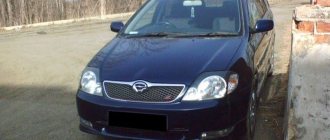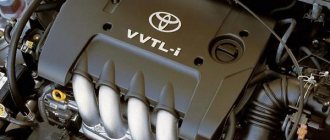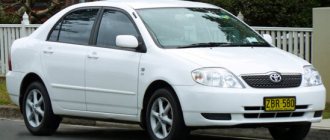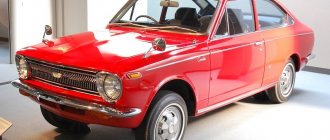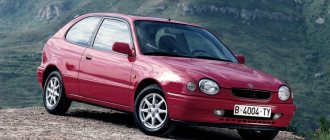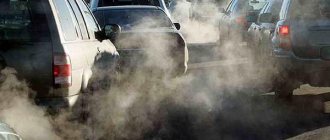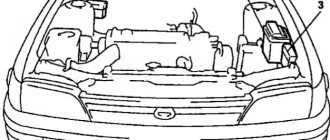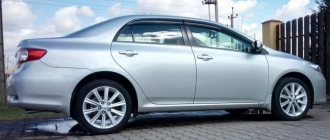Toyota Corolla is considered a bestseller in the automotive industry and is listed in the Guinness Book of Records as the best-selling model in the world. The ninth generation Toyota Corolla, designated E 120, was released in 2000. Sales started in 2001. The ninth generation Corolla was produced until 2006 in sedan, hatchback and station wagon versions. Toyota cars are very popular all over the world, thanks to the brand image as the most reliable and durable. The Corolla E120 was also faithful to traditions, giving many carefree years of ownership. But still, some “sores” could not be ignored. But first things first.
Engines
The Corolla E120 was equipped with gasoline engines with a VVT-i variable valve timing mechanism, which were represented by units with a displacement of 1.4 liters (97 hp), 1.6 liters (110 hp) and 1.8 liters (136 hp). hp). In addition to gasoline engines, the Corolla can also be equipped with a 2-liter diesel engine (90 hp).
Toyota engines are generally reliable and durable. They are able to overcome the 200 thousand km mark without causing any trouble. But about a third of owners encounter minor problems.
Gasoline units have a timing chain drive, the replacement of which is rarely required up to 200 thousand km. Some copies ran for up to 300 thousand km without replacing it. But the chain tensioner can give up even earlier - already by 90 thousand km. As a result of wear, the timing chain tensioner ring begins to leak oil.
A peculiarity of engine operation is vibration at idle speed after warming up. Sometimes a floating speed is added to this. This is mainly a problem with ZZ series motors. The reason is in the engine control program of the ECU, stitched to Euro 4 standards and not adapted to our gasoline. This process cannot be adjusted. This phenomenon is noticeable after 100,000 km. Attempts to correct the situation by replacing spark plugs, cleaning injectors and the throttle do not yield results. The “folk method” for getting rid of vibration is to increase the idle speed by increasing the load on the engine by turning on electrical consumers.
Engines of the 3ZZ series (1.6 l) are not tolerant of oil starvation. Even if nothing terrible happens immediately after this, the consequences can emerge after 20 - 30 thousand km. After 100 - 150 thousand km, oil consumption begins to increase. It is better to keep the oil level closer to the MAX mark.
In general, ZZ series engines are very picky about oil. Despite their high efficiency and good dynamic performance, these engines turned out to be the most “raw” and short-lived. The service life of the oil scraper rings of the first units was negligible, even despite careful maintenance and gentle operating conditions. The result is increased oil consumption. The reason is the loss of mobility of the oil scraper rings in the piston groove due to insufficient oil drainage and ineffective cooling of the piston crown.
Since 2005, 3ZZ engines have received a modified piston design, oil scraper rings and an increased oil supply of 0.5 liters. The number of complaints about increased oil consumption has decreased significantly.
Another feature of the ZZ series units is the absence of hydraulic compensators. They are not available on engines of the 4E-FE series (1.4 l). The valves are adjusted by selecting pushers, since shims are not provided. This operation is quite labor-intensive and expensive, and it must be carried out every 100 - 120 thousand km. As a rule, the need for this comes much later, and many owners never resort to this procedure.
On ZZ engines until 2003, rattling often appeared in the plastic intake manifold. The reason is the resonance of the vortex plate. Later the manifold design was changed and the problem disappeared.
On engines of the 1NZ series (1.6 l), hydraulic compensators began to be used, significantly facilitating their operation. Among the problems, owners note difficulty starting in cold weather. By 200,000 km, the valve cover of the cylinder head often begins to “snotty”.
Common problems include “UTT” (“morning trouble Toyota” - that’s what Coroll owners call it) - poor starting in cold weather after a long stay. An almost incurable feature. After 100 - 120 thousand km, the VVT-i valve timing clutch, thermostat may require replacement, and the rear crankshaft oil seal begins to leak. By 140,000 km, the poly V-belt tensioner bearing begins to whistle, and the rubber tip of the ignition coil cracks. After 150,000 km, a crack may appear at the intake manifold flange, next to the throttle valve. The oxygen sensors will also need to be replaced soon. Engine mount cushions may be ready for replacement when the mileage exceeds 160,000 km. Overheating of the engine will immediately require replacement of the valve stem seals. With a mileage of more than 200,000 km, there were cases of burnout of the intake valves. Difficulty starting may be caused by a clogged fuel filter in the fuel pump. If a warm engine does not start, it means the camshaft sensor has died. Interruptions in operation often occur due to contamination of the mass air flow sensor (mass air flow sensor).
Starter Bendix failure is common. It’s rare that anyone goes more than 100,000 km without replacing it. Signs: interruptions in starting, operation every other time, buzzing without cranking the engine. By 150,000 km, the bearing of the air conditioning compressor begins to make noise. And by 200,000 km the generator bearings get tired.
There is very little information on diesel engines, but they do not cause much trouble to their owners. Good diesel fuel and timely oil changes guarantee the reliability and durability of the diesel engine.
A Toyota Corolla with a 1.4 liter engine consumes about 11-12 liters per 100 km in the city, more powerful 1.6 liter and 1.8 liter engines consume a little less than 10 - 11 liters. On the highway, everyone's consumption is approximately the same, 6 - 7 liters. Record holder diesel unit with a consumption of 4-5 liters on the highway.
Transmission
1.4 liter engines are paired only with a manual transmission. The remaining engines are combined with both manual and automatic transmissions.
A manual transmission requires an oil change every 50,000 km. Some owners encountered the first problems already after a mileage of 100,000 km - the appearance of a squeak when the clutch was released. Its sources are the master cylinder rod and the pedal mounting location. A creaking sound when pressed occurs when moisture appears in the interior and comes from the clutch pedal return spring. By this time, a hum may appear in the box. The “weak spot” is the front bearings of the primary and secondary shafts, as well as the 3rd gear bearings. With a mileage of more than 100,000 km, problems sometimes appeared with gear shifting. The clutch lasts about 150,000 km.
The AISIN automatic transmission does not make itself known soon and is generally very reliable. Problems up to 200 - 250 thousand km are extremely rare. Some specimens survived to the mark of 600 thousand km!!! The automatic machine, of course, does not like sudden starts. The disease of U series boxes is the appearance of howling after 100-150 thousand km. The source is the front planetary gear due to play of the satellites on the axles. If you delay the repair, the oil seal may break, squeeze out the oil, and driving dry will lead to failure of the clutches. Timely repairs will cost 20 - 25 thousand rubles. With a mileage of more than 180,000 km, the gearshift cable may break, which will not allow the transmission to return to “P” mode and start the engine after parking.
Or choose another Toyota model:
The Q8 model has become a landmark for the Audi concern and has completely changed the understanding of the technical equipment of the concern's cars. Following the new product, serious changes took place in the design of all SUVs, and the design of the new products is already equal to the flagship Q8. But as expected, production of this car did not stop with the standard version. Soon after its successful launch in most target markets, the Q8 receives a sporty modification, the RS Q8. This is a completely different technical filling, more efficient use of every horsepower and every cubic centimeter of engine volume. With such features, the car became the most powerful, largest and most expensive in the history of the Audi concern. But that's not all.
Body
There are no complaints about the body hardware, if the car has not been in an accident. The metal and paint coating withstands aggressive environments. On the oldest examples, which are more than 10 years old, cracks appear in the outer rubber bands at the bottom of the door windows. Toyota Corolla body parts for the European and Japanese markets are overwhelmingly interchangeable, but for the American market they are individual, differing in fastenings. When selecting hardware, it is better to use an individual VIN code.
Corollas of 2003 - 2004 were subject to a massive recall due to problems with door locks. On the conveyor belt they stuffed it with grease, which thickened over time and the lock jammed. Dealers in car service centers removed them, washed them and installed them back. If one of the doors does not close through the central locking, most likely the reason is due to excessive lubrication.
Equipment
The Toyota Corolla E120 was offered to potential buyers in two trim levels, one of which was basic (Terra), and the other (Sol) was “charged”.
The standard equipment package seemed quite solid for the early 2000s. It included electric side mirrors in body color, heated rear window, telescopic and vertical steering wheel adjustment, the ability to manually adjust the seats, and central locking.
But that is not all. Also included in the basic package were automatic heated front seats, power windows, airbags (driver, passenger and side), ISOFIX mount, door stiffeners, tensioner and seat belt retainer with pretensioners. In addition, there was ABS, EBD, air conditioning, CD player, radio antenna, 4 speakers, on-board computer, immobilizer and even a spare tire.
In the “charged” configuration, of course, everything listed was also included. But it also added climate control, fog lights, audio controls on the steering wheel (with leather braid), curtain airbags and airbags with a deactivation function, rear parking sensors, a CD changer, 6 speakers, a rain sensor and a self-dimming rearview mirror. By the way, even versions in the Sol configuration had a high-strength body.
Interior
“Crickets” do not really like the interior of the Corolla in the back of the E120. They appear in the plastic above the speedometer and in the glass of the dashboard. If squeaks appear in the upper corners of the dashboard or at the bottom of the A-pillars, check the hood hinge and place a piece of porous rubber between the fender and the hood. There should be silence in the cabin.
On older cars, the windshield may leak. Over time, the steering wheel does not fix well in height, the reason is the weakening of the spring and fixation nuts; they need to be tightened.
Overall dimensions of Toyota Corolla cars
For most vehicles: cars, trucks, buses, overall dimensions are one of the most important characteristics.
Over the years, representatives of the Toyota Corolla series have changed not only the exterior, body type, technical equipment, but also the main dimensions: length, width and height. Dimensional changes are primarily related to the body type used, suspension features and type of drive (all-wheel drive or front-wheel drive).
Steering
The steering is the weakest point of the ninth generation Toyota Corolla. Steering rack knock is a disease that haunts many car owners. It appears already after a mileage of more than 60,000 km. There is nothing catastrophic about this, and the rattling rack goes on for a long time, causing only discomfort, but without affecting safety. The reason for the knocking sound is wear of the plastic bushings inside the rack. The radical solution is to replace the rack and it will cost 15-16 thousand rubles, but the problem will return after the next 60,000 km. A cheaper solution is to wrap foil around the shaft inside plastic bushings. The problem can be forgotten for 50 - 60 thousand km.
Depending on the configuration, the Toyota E120 was equipped with electric or hydraulic power steering, the latter being much more reliable. When the electric power steering is heavy, it is enough to reset the terminals from the battery for a while, after which everything returns to normal.
Story
After the end of the crisis that affected the previous generation, Toyota recovered and was ready to invest money again in the development of a new full-fledged car. The car was released in 2001 at the Frankfurt Motor Show, although the models appeared the previous year.
It is noteworthy that a separate version of the sedan was made for the USA, with the index E130. In an effort to reach the maximum audience, the manufacturer gradually released 6 bodies with the same appearance and some interchangeable body parts.
In 2003, the Japanese car underwent restyling, which slightly updated its appearance and affected the technical part. Sales of the tenth Corolla were successful, and in 2007 production was closed as the new generation E140 was ready.
Chassis
The chassis of the Toyota Corolla 120 cannot be called unkillable, but it is quite strong. Wheel bearings are the first to go, as a rule, when the mileage is more than 100,000 km, then the front silent blocks, stabilizer bushings and front shock absorbers come in line. Tie rod ends extend 100 - 150 thousand km.
Front brake discs are operational up to 100,000 km, rear brakes up to 150 - 200 thousand km. Front brake pads require replacement every 40 - 50 thousand km, and rear brake pads every 70 - 100 thousand km. When servicing brakes, special attention must be paid to the condition of the caliper boot. By 140 - 150 thousand km, a brake fluid leak may appear due to deformation of the boot, fine dust getting on the piston and cuff and their abrasion. The repair kit will cost 1000 rubles.
Prices
Successful sales and fanaticism brought a huge number of cars to the market. When looking around, do not cling to a specific option, there are many cars. The average price on the secondary market is 330,000 rubles , there are versions more expensive than 400,000 rubles, but not everyone is ready to pay that much.
To make the case for cheap servicing, here are the prices of some good quality aftermarket parts:
- oil pump – 1,900 rubles;
- chain tensioner – RUB 3,300;
- timing kit – 8,000 rubles;
- ball joint - 800 rub.;
- front lever – 3,000 rubles;
- rack support – RUB 1,900;
- rear silent block – 700 rub.;
- front shock absorber - 3,000 rubles.
The model has indeed lost a little of its former reliability; it is no longer such a “tank”. Nevertheless, compared to its competitors, it still remains one; you are unlikely to find a car of these ready-made models in such a budget, which breaks down so rarely and is so cheap to maintain. If you manage to find a Toyota Corolla E120 with a mileage of about 200 thousand kilometers, you will most likely drive another 150,000 without any special interventions.
Electrics
Electricians periodically remind themselves of themselves with minor ailments. First on the list is a beep. Periodically plays “silent”, triggering every other time. The problem is himself. The Air Bag airbag control cable in the steering column may be broken.
If the wipers stop turning on, then most likely the contact on the switch has become unsoldered. And if the windshield washers stop working, it means the wire in the washer pump plug has “rotten”. Often, at 120 thousand km, the interior lighting stops turning on and the warning light does not go off when the doors are opened. The reason is souring of the limit switch. From time to time, “glitches” of the clock and radio occur - the backlight disappears. More often than others, the backlight of the climate/air conditioning switch burns out. Some owners complain about periodic loss of contact in the fuse box (in the passenger compartment). Closes the list of “glitches” of power windows, expressed in the spontaneous opening of the windows or the inability to control them. The reason is water getting inside the door after deep puddles or washing.
